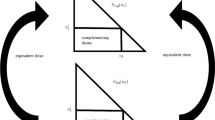Abstract
This article presents and illustrates an approach to designing and analyzing studies involving mixtures/combinations of drugs or chemicals along fixed-ratio rays of the drugs or chemicals for generalized linear models. When interest can be restricted to a specific ray, we consider fixed-ratio ray designs to reduce the amount of experimental effort. When a ray design is used, we have shown that the hypothesis of additivity can be rejected when higher order polynomial terms are required in the total dose-response model. Thus, it is important that we have precise parameter estimates for these higher order polynomial terms in the linear predictor. We have developed methodology for finding a D s -optimal design based on this subset of the terms in the linear predictor.
Similar content being viewed by others
References
Abdelbasit, K. M., and Plackett, R. L. (1983), “Experimental Design for Binary Data,” Advanced Cancer Research, 35, 269–335.
Atkinson, A., and Donev, A. (1992), Optimum Experimental Designs, Oxford: Oxford University Press.
Berenbaum, M. C. (1985), “The Expected Effect of a Combination of Agents: The General Solution,” Journal of Theoretical Biology, 114, 413–431.
Bruden, M., and Vidmar, T. (1989), “Optimal 3×3 Factorial and 3-ray Designs for Drug Interaction Experiments with Dichotomous Responses,” Communications in Statistics, 18, 2835–2859.
Dawson, K. S., Carter, Jr., W. H., and Gennings, C. (2000), “A Statistical Test for Detecting and Characterizing Departures from Additivity in Drug/Chemical Combinations,” Journal of Agricultural, Biological, and Environmental Statistics, 5, 342–359.
Finney, D. J. (1964), Statistical Methods in Biological Assay (2nd ed.), London: Charles Griffin & Co.
Gennings, C., and Carter, W. H., Jr. (1995), “Utilizing Concentration-Response Data from Individual Components to Detect Statistically Significant Departures from Additivity in Chemical Mixtures,” Biometrics, 51, 1264–1277.
Gennings, C., Schwartz, P., Carter, W. H., Jr., and Simmons, J. E. (1997), “Detection of Departures from Additivity in Mixtures of Many Chemicals with a Threshold Model,” Journal of Agricultural, Biological, and Environmental Statistics, 2, 198–211.
Gennings, C., Schwartz, P., Carter, W. H., Jr., and Simmons, J. E. (2000), “ERRATUM: Detection of Departures From Additivity in Mixtures of Many Chemicals With a Threshold Model,” Journal of Agricultural, Biological, and Environmental Statistics, 5, 257–259.
Gennings, C., Carter, W. H., Jr., Campain, J., Bae, D., and Yang, R. (2002), “Statistical Analysis of Interactive Cytotoxicity in Human Epidermal Keratinocytes Following Exposure to a Mixture of Four Metals,” Journal of Agricultural, Biological, and Environmental Statistics, 7, 58–73.
Kelly, C., and Rice, J. (1990), “Monotone Smoothing with Application to Dose-Response Curves and the Assessment of Synergism,” Biometrics, 46, 1071–1085.
Kiefer, J., and Wolfowitz, J. (1959), “Optimum Designs In Regression Problems,” The Annals of Mathematical Statistics, 30, 271–294.
Loewe, S. (1953), “The Problem of Synergism and Antagonism of Combined Drugs,” Arzneimittle Forshung, 3, 285–290.
Loewe, S., and Muischnek, H. (1926), “Uber Kombinationswirkunger. I. Mitteilung: Hiltsmittel der Gragstellung. Naunyn-Schmiedebergs,” Archives of Pharmacology, 114, 313–326.
Mantel, N. (1958), “An Experimental Design in Combination Chemotherapy,” Annals of the New York Academy of Sciences, 76, 909.
Martin, J. T. (1942), “The Problem of the Evaluation of Rotenone-containing Plants. VI. The Toxicity of 1-elliptone and of Poisons Applied Jointly, with Further Observations on the Rotenone Equivalent Method of Assessing the Toxicity of Derris Root,” Annals of Applied Biology, 29, 69–81.
McCullagh, P. (1983), “Quasi-Likelihood Functions,” The Annals of Statisitcs, 11, 59–67.
McCullagh, P., and Nelder, J. A. (1989), Generalized Linear Models (2nd ed.), New York: Chapman and Hall.
McDonald, A., Gennings, C., Hartley, W., Teuschler, L. K., Thiyagarajah, A., Sey, Y. M., Krasner, S. W., and Simmons, J. E. (1999), “The Effect of Mixing Ratio on the Hepatotoxicity of Trihalomethane Disinfection Byproducts,” The Toxicologist, 48, 110.
Minkin, S. (1987), “Optimal Designs for Binary Data,” Journal of the American Statistical Association, 82, 1098–1103.
Myers, W. R., Myers, R. H., Carter, W. H., Jr., and White, K. L., Jr. (1996), “Two-Stage Designs for the Logistic Regression Model in Single-Agent Bioassays,” Journal of Biopharmaceutical Statistics, 6, 283–301.
Nelder, J. A., and Mead, R. (1965), “A Simplex Method for Function Minimization,” The Computer Journal, 7, 308–313.
Author information
Authors and Affiliations
Rights and permissions
About this article
Cite this article
Meadows-Shropshire, S.L., Gennings, C., Carter, W.H. et al. Analysis of mixtures of drugs/chemicals along a fixed-ratio ray without single-chemical data to support an additivity model. JABES 9, 500 (2004). https://doi.org/10.1198/108571104X16312
Received:
Revised:
DOI: https://doi.org/10.1198/108571104X16312




